
The PC is an interesting platform as a choice for gamers. It provides options and alternatives unbound by the constraints and limitations of consoles. In the past few years however we’ve seen an interesting route in how the platform has evolved, and how it’s branched out to expand its audience.
Over the course of 8 years during the time in which the Xbox 360 was the dominant gaming platform, with the PlayStation 3 and the Nintendo Wii just behind it. The rate at which technology has progressed has accelerated drastically.
During the first couple of years in the lifespan of these three gaming consoles there was an interesting shift in the preference that gamers had towards experiencing their games, And I’m not talking about Wii-motes, finger reading cameras, and light gun peripherals that get abandoned within their first month of release.
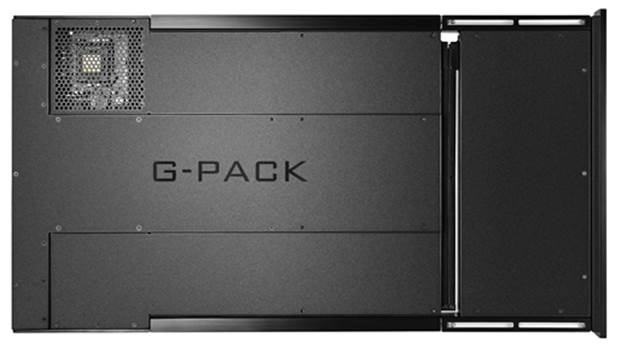
Needless to say the attractiveness in PC was starting to rise and while a share fair of people are aware of the differences that reside between a PC and a console when it comes to gaming, it was during this era of gaming that the differences began to exceedingly widen. And not just in terms of gaming preference and experience, but on a technological one also.
It’s no secret that the PC platform is a leap ahead of consoles in terms of a game’s visuals qualities and performance measurements, but there’s much more to it than that. When the Xbox 360 launched and the PlayStation 3 shortly after it back in 2007, on a technological stance they were comparable to a mid-range gaming PC of that time.
The benefit however was that although they were pretty expensive systems, they were still more price friendly than an actual mid-tier gaming PC, not to mention more user-friendly. However, as the next few years began to unravel and technology started to move a much faster rate. Due to design tradition, pricing, as well as physical limitations…some things did not.
Smart-phones for example had started to become exceedingly powerful, doubling their performance with every year that followed. But the real kicker here was the PC, as the leaps in technology refused to slow down it was the PC that benefited the most from this. Along with these ever rising gains in performance it also became incredibly cheaper for people to get in to PC gaming.
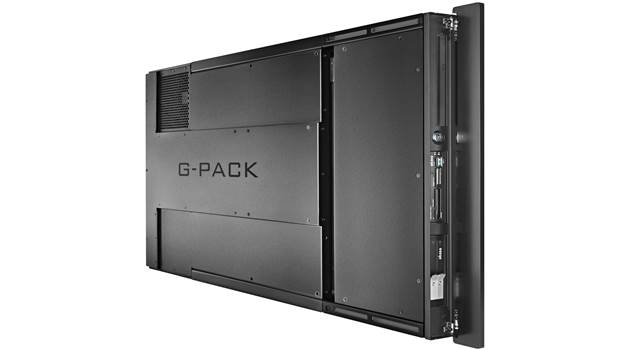
While there are some undoubtedly impressive looking games on the Xbox 360 as well as the PlayStation 3, it’s certain games like the original Crysis that released back in 2007 from developer Crytek, that raised the new standard for what PCs should be aiming for.
Regardless of just how powerful these two consoles once were at the time of the release, they just wasn’t up to scratch for meeting the requirements in order to play Crysis. And so, this title was strictly reserved for the high-end PCs.
As the price for PC gaming has continued to fall while the performance has been on a non-stop rise, it was best said in 2013 by Cevat Yerli the co-founder, CEO and President of Crytek in an interview with Eurogamer: “If you predict how hardware evolves at the current speed of evolution, and then take consumer pricing evolution, already two years ago you could see, whatever launches in 2013 or 2014 or 2015, will never beat a PC again”.
With the hundreds of exclusive titles that are only available on the PC, along with the ninety percent of titles on console also available on the PC all of which are near half the price of their console counterparts, the benefits are very impressive.
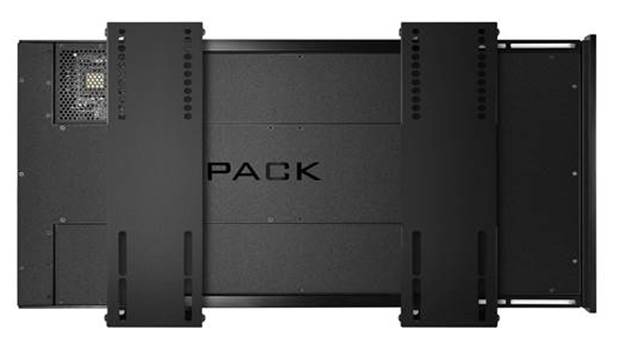
Taking into account that there’s no fee for online gaming, the visuals of these games are always “Next-Gen”, backwards compatibility will always be there, and user-based creation extends the life of older games in the form of Mods. It has never been a better time to be a PC gamer.
Along with Valve’s Steam Big-Picture mode which replaces your Windows, Linux, or Mac desktop for a console-like interface, all one really has to do is plug in a controller and they’re good to go.
With a large number of companies such as Origin, Dino PC, CyberPowerPC, Razer, MainGear, and so many others that offer pre-built gaming PCs at many variable configurations and prices.
The knowledge that was once required to just get your foot in the door of PC gaming has now been kicked off the hinges. Along with many physical form factors of PCs ranging from towers to cubes, and console comparable sizes right down to something that can fit in to the palm of your hand such as Gigabyte’s Brix Gaming PC.
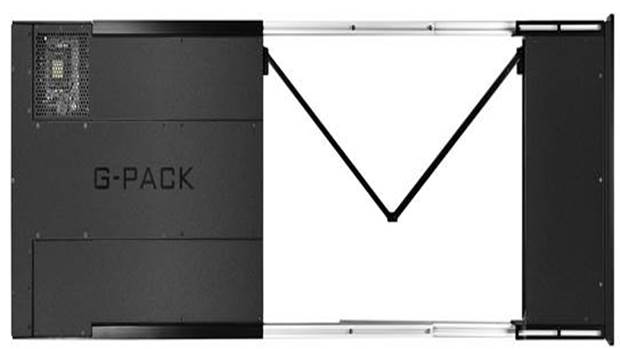
The choice is endless and with many of these companies attempting to release consumer-friendly priced PCs that outperform Microsoft and Sony’s latest game consoles, which has been something of a large debate since they were initially launched. With the systems being regarded as underpowered and technologically outdated it aids in this movement.
There has been one set of individuals that aren’t in anyway shy about publicly mocking these two systems, and they’ve proudly got the Tweets to prove it. They’ve also got the technological balls to back it up, and will be releasing something in the year to come that provides gamers with a high-performance solution to an Xbox, Nintendo, or a PlayStation.
Appropriately nicknamed “The Invisible PC” created by Computer hardware company PiixL, enter the G-Pack. A television mounted Gaming PC that sits flat behind your screen using a custom built frame. The G-Pack provides user-friendly accessibility and upgradability, an easy to use mounting system, an adequate cooling solution, and all is achieved while remaining a high performing, relatively light weight machine that’s near silent on the decibel scale when actually in use.
Using this custom Vesa mounting system the G-Pack is designed to simply slide in and out of the frame should the user want to tweak or open up the system. While my initial thoughts on the system were quite sceptical to the say the least, getting hands-on with the system and having the privilege take it apart and analyse the hardware and design for myself, I was convinced.

Having doubts about just how cool the system would remain should it take advantage of full-size desktop hardware, I initially thought there would be comprises in the system and it would resort to laptop-tier hardware.
Which in comparison to a desktop grade gaming PC would be underpowered and not so upgradable. How wrong was I? Using a well engineered design and layout of compartments, high-performance blower-style fans, and a riser card to the slot the graphics card in to place.
The slim form factor of the system is not much thicker if actually thinner than your standard flat screen television. Utilizing an M-ITX size motherboard and a custom CPU heatsink, the G-Pack makes no compromises in providing gamers with easy access usability and reach for it’s I/O ports, display connections, power cable, USB ports, which are all positioned to the side of the chassis.
What’s unique about the G-Pack’s design is the way in which the it deals with power consumption and heat while remaining cool and quite. While the system is by no means a hot and sweaty power hog, it does make efficient use of the way it deals with heat dissipation in order to remain high-performing and long lasting.
Designed with each piece of hardware sectioned off in to its own compartment equipped with fans that direct heat to the side of the chassis, the upgradability that the system provides should users wish to actually do so hasn’t been sacrificed by any means.
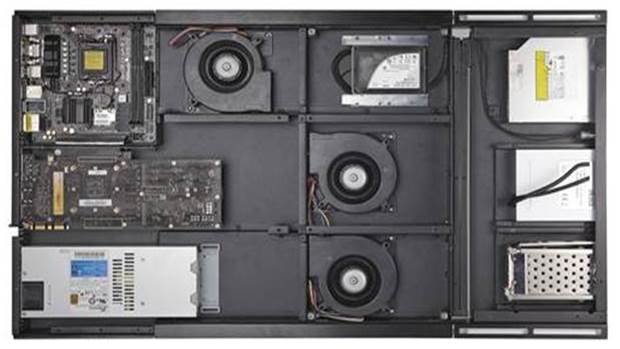
The system is designed to mount on any TV from 32 inches and above, due to the design of it’s frame. This is achieved through the extendibility of the frame itself which feeds cables through the interior of the chassis while extending along the mount to fit the given size of the screen.
The system supports any TV up to one hundred kilograms of weight and accomplishes this by using a strong and durable aluminium frame. Although the system is still in prototype stages the unit I previewed appeared near enough to be a final product.
The aesthetics as well as the hardware was supremely well chosen and designed, and it looks sleek and stylish. Equipped with an Intel i7 processor, 8GB of system RAM, a 3GB Nvidia GTX780, and a 500 Watt SilverStone power supply, this prototype was quite impressive. With sections for hot swappable hard drives, SSDs, a card reader, and a slimline optical drive bay, the question of which if any configurations will be available during launch still remains to be answered.
Each system however will be launching with an included game pad and Windows 8.1,in order to combat the console style user-interface of controller-friendly navigation and an ease of use approach to break down the walls that stand between the PC desktop and a user’s games.
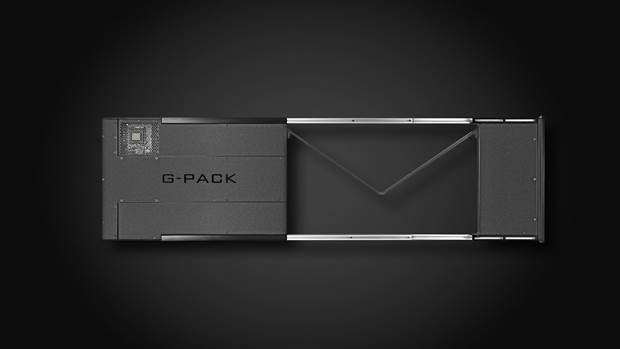
The G-Pack will be using Steam’s Big-Picture mode so that users will never have to see the desktop again, but should they use to wish Windows, Mac, Linux, or whatever PC operating system they like, the G-Pack is just as functional as a regular PC if not overpowered, and they’re welcome to do so. Just simply close down Steam and it’s good go.
What further tweaks PiixL may be using to allow the system to be more gamer-orientated is still up in the air. But as the majority of PC gamers now use Steam’s Big-picture mode anyway it’s safe to say this hurdle has already been overcome.
Should Valve release their Linux based operating system known as Steam OS, it’s also highly likely that there will be models of the G-Pack using this as an alternative to the Windows based Steam OS -Big Picture mode. As for when the G-Pack is available for consumers it is aimed to launch towards the end of this year.
The G-Pack is planned to hit KickStarter very soon although no official date has been given. While no official price has been announced either, or any specific configurations for consumers of different budgets, the company has stated that they will be attempting to make the product as accessible as possible for the consumers.
But that they’re also heavily focused on a no-compromise approach on delivering a high-performance yet compact system, that does away with the traditional gaming PC tower-style aesthetics, as well as the standard square box-style to that of a gaming console.
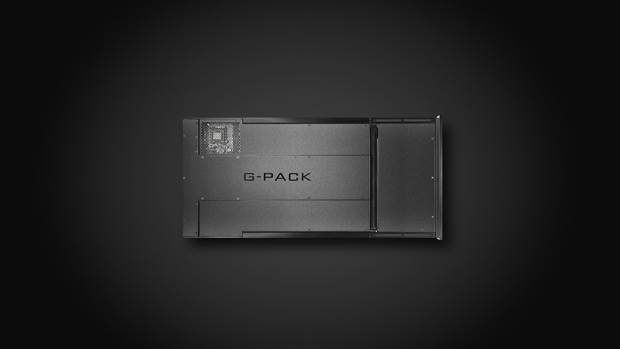
It’s clear that the team is passionate about the PC gaming platform and that they’re highly intent of delivering a product that demonstrates the platforms features and advantages. After getting my hands-on time with the hardware itself I tested the actual usability of what’s actually on screen, and benchmarked a few games for curiosity.
Testing games such as Battlefield 4, Metro: Last Light, Crysis 3, Grid 2, Hitman:Absolution, and good old TowerFall: Ascension just for sheer enjoyability, all playable at their highest quality settings of 60 frames per second and above at a resolution of 1920 by 1080p. I expected nothing less from a GTX780 3GB.
Purposely testing a varied set of the most demanding games of this generation with Crysis 3 in particular, that has undoubtedly set the new graphical standard of games for years to come since it’s release last year. It’s clear that the G-Pack is a powerful machine.
If it is infact true that Nvidia are said to be releasing their new series of graphics cards this year along with the many options available already from AMD, we may infact see a change in hardware choices to the system. What hardware configurations will be available for the G-Pack it something that interests me the most.
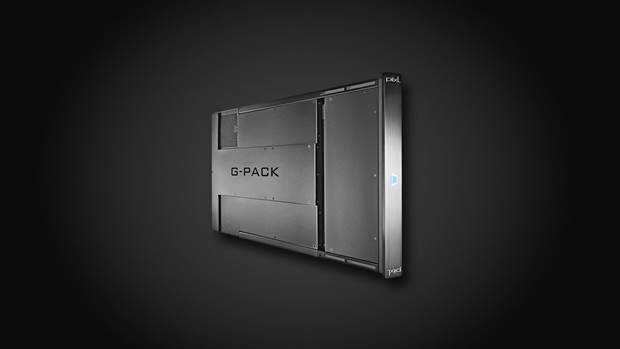
The on-screen controller navigation made possible by Big-Picture mode functions flawlessly and as an avid user of the software myself I felt right at home from the moment I picked up the controller.
What’s great about Steam’s Big-Picture mode is the constant improvements and features that Valve has been adding since the time of its release. The common goal here for taking over for the living room as the number one choice for gamers is evident. A console interface replacement and a PC stuck to the back of your TV, it’s a good thing that games are also available digitally.
Combining a console interface directly in to it’s Steam Store where gamers can purchase their games digitally and have them download and install in the background, while frustratingly deciding what game to play from their massive library, that they’ll inevitably build up due to Steam’s insanely cheap pricing on their games is always a blessing. It’s buffet for one and you never get full.
As Steam has been getting more and more features such as in-home streaming, mobile updates, integrated Mod support from the community, Steam trading cards, a built-in web browser, Family sharing, and support for Virtual Reality devices. The idea of strapping your PC to the back of your TV suddenly seems like a pretty cool idea.
More information about the G-Pack can be found over on the company’s website:www.piixl.com
Amazing Articles You Might Want To Check Out!
Keep On Reading!

Halo: Campaign Evolved Uses AI-Based Tools for Development
Executive producer Damon Conn and game director Greg Hermann noted that AI is simply a tool rather than replac...

Pokémon Legends: Z-A Became the Best-Selling Title in Europe on Its Debut, But Fell Short of Arceus
Physical sales in the region were down 28 percent compared to the 2022 title, and unit sales are the lowest si...

Sony Does Not Have Plans to Bid for Acquisition of Warner Bros. Discovery
Rather than making major deals in the US film industry, Sony is interested in "growth markets" with double-dig...

Stray is Coming to PlayStation Plus Essential in November – Rumor
BlueTwelve Studio's feline-coded adventure game, which released to strong critical acclaim in 2022, is apparen...

Dying Light: The Beast’s New Game+, Legend Levels and Nightmare Mode Detailed
Most of the major updates coming to Dying Light: The Beast over the 11-week plan set forth by Techland revolve...

Cancelled Multiplayer God of War Screenshots Leaked – Rumour
Leaked screenshots of the cancelled project indicate that it would have taken players back to the God of War's...








